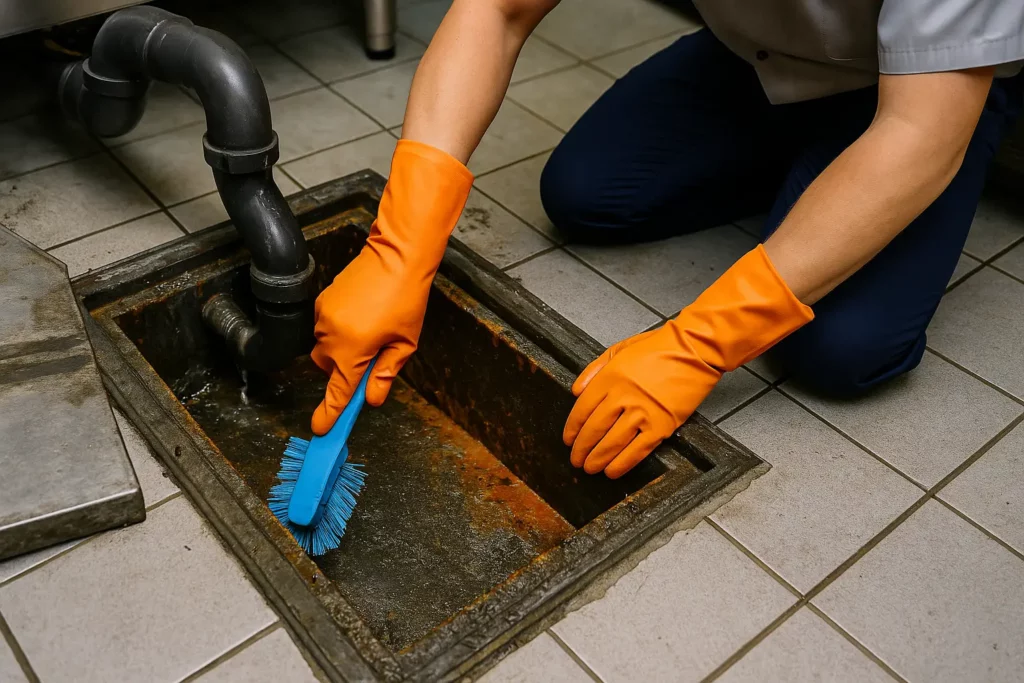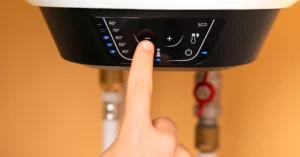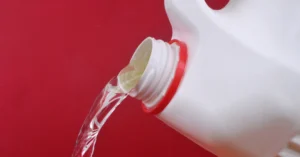If you’re noticing a foul smell around your kitchen or prep area (something that reminds you of raw sewage or rotten eggs), your grease trap could be the problem. That odor is more than unpleasant. It can affect your health, drive away customers, and signal deeper plumbing issues.
Whether you’re running a busy restaurant or just trying to keep your home kitchen clean, a smelly grease trap is something you shouldn’t ignore.
At Solid Plumbing & Drains, Inc., we’ve helped hundreds of clients deal with grease trap issues across San Diego. In this guide, we’ll walk you through the most common causes of that nasty sewage smell, how to prevent it, and what to do if it’s already stinking up your space.
Why Does My Grease Trap Smell Like Sewage?
A grease trap is designed to catch fats, oils, and grease (often called FOG) before they reach your sewer line. Over time, if the trap isn’t cleaned or maintained properly, that waste starts to rot. As it breaks down, it creates gases like hydrogen sulfide, the same gas that gives sewage its awful smell.
That’s what you’re smelling.
The problem is especially common in:
- Restaurants and commercial kitchens
- Cafeterias and catering spaces
- Homes with under-sink grease traps or older plumbing setups\
It’s not just annoying, it could be a sign of a plumbing issue that’s been building for a while.
Who Is Affected by Grease Trap Odors?
If you operate a commercial kitchen, this problem hits hard. That sewer smell can travel fast and ruin the experience for diners. Even worse, it can raise health code red flags, something no restaurant owner wants.
For homeowners, the smell can make cooking or doing dishes unbearable. It might also hint at a bigger issue with your home’s drainage system.
Whether it’s business or residential, grease trap smells affect comfort, safety, and reputation.
The Top Reasons Grease Traps Start to Smell
Let’s break down the usual suspects behind that sewer-like stench:
Grease Buildup Over Time
FOG collects quickly, especially in high-use kitchens. If your grease trap isn’t cleaned often enough, the grease solidifies and begins to decompose. The result? A thick, stinky mess that smells worse every day.
Dry Trap Seals
Your grease trap or nearby floor drains might have a P-trap, a curved pipe section that holds water to block sewer gases. If water isn’t running through it regularly, the trap dries out and loses its seal. This allows bad odors to come right back into the kitchen.
Blocked Vent Lines
Grease traps need venting to release gases properly. If the vent pipe is clogged or blocked, those gases can get trapped and push back through your drains.
Improper or Infrequent Cleaning
Just because your trap “looks okay” from the outside doesn’t mean it’s clean. Even if water still drains, that doesn’t mean grease isn’t sitting inside. Skipping cleanings is one of the fastest ways to develop strong odors.
Biofilm and Bacteria Growth
Inside every trap is a hidden world of bacteria. When waste sits too long, bacteria form sticky layers (biofilm) that grow on the walls of the trap and pipes. This sludge is hard to remove and gives off a very distinct “sewage” odor.
What Happens If You Ignore a Smelly Grease Trap?
It’s easy to think: “It’s just a smell, we’ll deal with it later.” But waiting too long can lead to bigger problems.
If you don’t address the odor, you might end up with:
- Health Code Violations: In commercial spaces, even one complaint can lead to a visit from the health department.
- Lost Customers: Diners don’t return to restaurants that smell like dirty drains.
- Drain Backups: A clogged grease trap can stop water from draining and cause backups in sinks and floor drains.
- Increased Pest Activity: Rodents, roaches, and flies are all drawn to the smell of rotting grease.
- Permanent Pipe Damage: Old grease and bacteria can eat away at pipe walls, especially in older systems.

How to Get Rid of the Sewage Smell from a Grease Trap
If your grease trap already smells like sewage, here’s what you can do:
Clean the Trap Thoroughly
Remove the lid and scoop out any solids, followed by flushing the trap with warm water. Use a degreaser to scrub the interior walls. (Make sure to wear gloves and a mask; it won’t smell good.)
Use Enzyme-Based Cleaners
These products use “good” bacteria to break down fats and eliminate odors. They’re safer than chemical drain cleaners and can help reduce buildup over time.
Flush Nearby Drains
Pour a bucket of water into nearby floor drains to refill dry P-traps. This creates a barrier to block sewer gas from coming back into the room.
Call a Professional for Deep Cleaning
If the smell doesn’t go away or if the trap hasn’t been cleaned in a while, call Solid Plumbing & Drains, Inc. We use specialized vacuum equipment and non-toxic cleaning agents to fully pump out and flush the trap, not just rinse it.
How to Prevent Grease Trap Odors from Coming Back
Smells always come back if the trap isn’t cleaned and maintained. Here’s how to prevent that:
Set a Regular Cleaning Schedule
- For busy kitchens: clean every 1–2 weeks
- For homes or light commercial: every 1–3 months
Our team can help set up a service plan based on your usage.
Don’t Pour These Down the Drain
Avoid dumping:
- Cooking oil
- Meat scraps
- Sauces and gravies
- Starchy foods like rice and pasta
These all speed up grease buildup.
Keep Water Flowing Through Drains
Pour water into unused drains weekly to keep trap seals from drying out. Add a dash of vinegar or baking soda to help control bacteria.
Train Your Staff (Or Household)
A quick 5-minute training on what can and can’t go down the drain can save hundreds of dollars in emergency plumbing calls.
When to Call a Plumber (And What We Do to Help)
If you’ve cleaned your grease trap and it still smells like sewage, it’s time to bring in a licensed plumber. At Solid Plumbing & Drains, Inc., we offer fast, professional grease trap service in both homes and commercial settings.
Our Service Includes:
- Full pump-out of your trap
- Inspection for vent clogs or pipe issues
- Odor-neutralizing rinse
- Optional enzyme dosing
- Follow-up scheduling to prevent future smells
Transparent Pricing
We offer clear pricing with no hidden fees. Whether you need a one-time cleaning or want to set up a recurring service, we’ll build a plan that fits your kitchen’s needs and budget.
Don’t Let a Bad Smell Turn Into a Big Problem
A smelly grease trap might seem like a small annoyance, but it can quickly grow into a health issue, a customer complaint, or even a serious plumbing emergency.
By understanding what causes the smell, staying on top of cleaning, and calling for help when needed, you can keep your kitchen running safely and odor-free.
Need Help With a Grease Trap That Smells Like Sewage?
Solid Plumbing & Drains, Inc. is here to help, fast. Whether your kitchen is in a restaurant, food truck, or your own home, we know how to get rid of the smell, clean your trap the right way, and keep your pipes clear.




